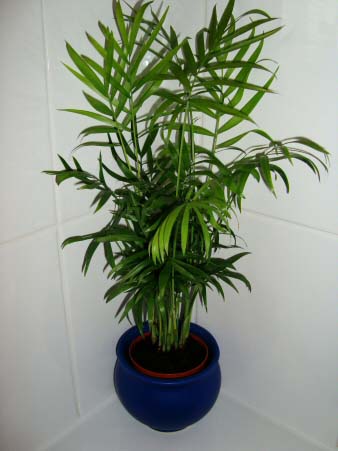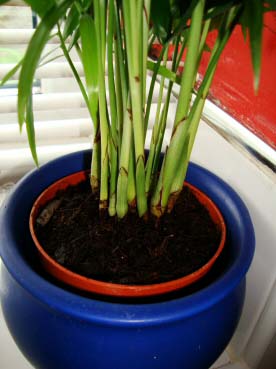





The Parlour Palm, or Parlor Palm in America, or by its latin name of Neanthe bella is one of the most sought after indoor palms around today.  The reasons for this couldn't be more straight forward - It thrives in our homes and workplaces where other species may struggle and is one of the cheapest palms you can buy. Popular since Victorian times it has kept hold of this prestige through its easy going adaptive attitude to low light and humidity levels, all the while being effective at cleaning the air and making it on to NASA's list of 50 Indoor plants that clean the air. This is an equally great plant to start with for the beginner or the seasoned houseplant collector.
The reasons for this couldn't be more straight forward - It thrives in our homes and workplaces where other species may struggle and is one of the cheapest palms you can buy. Popular since Victorian times it has kept hold of this prestige through its easy going adaptive attitude to low light and humidity levels, all the while being effective at cleaning the air and making it on to NASA's list of 50 Indoor plants that clean the air. This is an equally great plant to start with for the beginner or the seasoned houseplant collector.
The beautiful, attractive and delicate appearance of the Parlour Palm is made up of light green fronds about 8in / 20cm long that have a dainty like texture which are loved by interior designers. Whilst a slow grower it should reach a respectable indoor height of 2ft / 60cm within only a few years, after which you may (with good light) receive regular clusters of flowers and for a palm kept indoors that is pretty rare.
It's typically sold as a cluster of smaller plants and thereby it creates an immediate compact, full and almost bushy appearance which is easy to mistake for a well grown single potted up plant. Casting your eyes down to where the multiple number of stems emerge out of the soil will give the game away though!
When searching in the shops, textbooks or other websites, it may not be listed as Neanthe bella and instead you may find it going by Collinia elegans or Chamaedorea elegans. Ultimately like many palms there is only one cultivar you can generally buy and so providing you can recognise it by sight (look at the pictures on this page for that) you will know immediately if you are looking at a true Neanthe bella or not.
Light
Low light will be tolerated but like all houseplants deep shade will not go down well (unless for only short periods). Some sun will be helpful, but harsh sunshine will scorch the leaves. The perfect spot for your Parlour Palm therefore should be bright with a little sun in early morning or late afternoon. Have a read of our Light Guide if you want some further food for thought about placement.
Watering
Underwatering a Parlour Palm is better than overwatering. Water well then wait until the surface of the soil has dried out, at which point water well again. Limit the amount of water given when light or temperature levels are low simply because in those conditions plant's don't use as much water.
Humidity
Red Spider Mite can be an issue if humidity is very low or there is a lot of dry air around the leaves, for example if placed near a working radiator. However, providing Spider Mites aren't a problem this is a palm that really doesn't care about low or high humidity.
Limit the amount of water when light or temperature levels are low
Feeding
Because there are often several plants in a single pot all fighting for the limited number of nutrients in the soil, you should look to feed on a semi regular basis. That said, these palms are still relatively small and don't need masses of feed to do well. A general feed once every couple of months will be enough.
Temperature
Warmth is needed for actual growth to occur (20°C - 27°C / 68°F - 80°F). A lower temperature is fine as the plant will still survive providing it doesn't dip much below 10°C / 50°F, just be aware that slow or no growth might be symptom of the temperature being too cold.
Repotting
Palms do not like root disturbance and because they have weak root systems frequent repotting can be damaging over the long term. Despite this warning, young plants will often still need to be repotted once a year until they reach a mature size.  Only repot after this point once the potting media breaks down and starts to effect your watering efforts, i.e. the water constantly drains out leaving the soil dry or it instead becomes like a sponge and results in a soggy mess.
Only repot after this point once the potting media breaks down and starts to effect your watering efforts, i.e. the water constantly drains out leaving the soil dry or it instead becomes like a sponge and results in a soggy mess.
Your average everyday compost from the garden centre is all that is required, but you should make sure it is packed quite tightly around the root ball.
Propagation
As mentioned in our introduction section above, Neanthe bella is often sold in clusters of several plants, as you can see in the picture on the right. This means you can look to increase your stock through division. Be warned when you divide a plant you effect its appearance in a big way so think carefully before you do it.
Speed of Growth
Even in a bright location, if the temperature is high and you water perfectly, growth is still rather slow. With that said, maturity is reached after only a few years because the ultimate height and spread tends to be on the dwarf size when comparing all the different palms species side by side.
Height / Spread
Few indoor plants will ever be taller than 3ft / 1m, although 6ft / 1.8m is not unheard of. The spread will narrow towards the base and become wider as you move upwards.
Flowers
Small flowers and sometimes even small seeds do appear quite often throughout the year on a mature well grown and well cared for Parlour Palm.
Anything else?
You must never "prune" or cut off healthy green fronds and this is because they have only one point of growth, which if removed will stop growth on that part dead in it's tracks. Lower fronds will naturally die and brown over time though and you should cut them off to maintain the overall attractive appearance.
Copyright © www.100flowers.win Botanic Garden All Rights Reserved